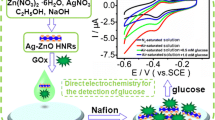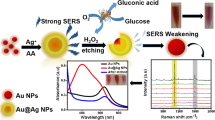Abstract
An effective and robust colorimetric sensor array for simultaneous detection and discrimination of five reducing sugars (i.e., glyceraldehyde (Gly), fructose (Fru), glucose (Glu), maltose (Mal), and ribose (Rib)) has been proposed. In the sensor array, two negatively charged polydielectrics (sodium polystyrenesulfonate (NaPSS) and sodium polymethacrylate (NaPMAA)), which served as the sensing elements, were individually absorbed on the surface of the cetyltrimethylammonium bromide (CTAB)-coated gold nanorods (AuNR) with positive charges through electrostatic action, forming the designed sensor units (NaPSS-AuNR and NaPMAA-AuNR). In the presence of Tollens reagent (Ag(NH3)2OH), Ag+ was absorbed on the surface of negatively charged NaPSS-AuNR and NaPMAA-AuNRs. When confronted with differential reducing sugars, different reducing sugars exhibited differential levels of deoxidizing abilities toward Ag+, thus Ag+ was reduced to diverse amounts of silver nanoparticles (AgNPs) in situ to form core-shell AuNR@AgNP by the traditional Tollens reaction method, leading to distinct colorimetric response patterns (value of AS/AL (the ratio of absorbance at 360 nm to that at 760 nm in Ag+-NaPMAA-AuNR, and the ratio of absorbance at 360 nm to that at 740 nm in Ag+-NaPSS-AuNR)). These response patterns are characteristic for each reducing sugar, and can be quantitatively distinguished by linear discriminant analysis (LDA) at concentrations as low as 10 nM with relative standard deviation (RSD) of 4.11% (n = 3). The practicability of this sensor array has been validated by recognition of reducing sugars in serum and urine samples.
Graphical abstract

A colorimetric sensor array for reducing sugar discrimination based on the reduction of Ag+ and in situ formation of AuNR@AgNP.









Similar content being viewed by others
References
Cummings JH, Stephen AM (2007) Carbohydrate terminology and classification. Eur J Clin Nutr 61:S5–S18
Dwek RA (1996) Glycobiology: toward understanding the function of sugars [J]. Chem Rev 96:683–720
Siddiqui H, Sami F, Hayat S (2019) Glucose: sweet or bitter effects in plants-a review on current and future perspective. Carbohydr Res 487. https://doi.org/10.1016/j.carres.2019.107884
Scandurra A, Ruffino F, Sanzaro S, Grimaldi MG (2019) Laser and thermal dewetting of gold layer onto graphene paper for non-enzymatic electrochemical detection of glucose and fructose. Sensors Actuators B Chem 301:127113
Kim S, Jeon C, Lee G, Koo J, Cho SH, Han S, Shin MH, Sim JY, Hahn SK (2019) Hyaluronate-gold nanoparticle/glucose oxidase complex for highly sensitive wireless noninvasive glucose sensors. ACS Appl Mater Interfaces 11:37347–37356
Teymourian H, Moonla C, Tehrani F, Vargas E, Aghavali R, Barfidokht A, Tangkuaram T, Mercier PP, Dassau E, Wang J (2020) Microneedle-based detection of ketone bodies along with glucose and lactate: toward real-time continuous interstitial fluid monitoring of diabetic ketosis and ketoacidosis. Anal Chem 92:2291–2300
Suzuki Y, Kano K, Shirai O, Kitazumi Y (2020) Diffusion-limited electrochemical d-fructose sensor based on direct electron transfer-type bioelectrocatalysis by a variant of d-fructose dehydrogenase at a porous gold microelectrode. J Electroanal Chem 877:114651
Liu A, Lang Q, Liang B, Shi J (2017) Sensitive detection of maltose and glucose based on dual enzyme-displayed bacteria electrochemical biosensor. Biosens Bioelectron 87:25–30
Le NC, Gel M, Zhu Y, Dacres H, Anderson A, Trowell SC (2014) Real-time, continuous detection of maltose using bioluminescence resonance energy transfer (BRET) on a microfluidic system. Biosens Bioelectron 62:177–181
Borji A, Borji F, Jourani A (2017) A new method for the determination of sucrose concentration in a pure and impure system: spectrophotometric method. Int J Anal Chem 2017:8214120
Ilaslan K, Boyaci IH, Topcu A (2015) Rapid analysis of glucose, fructose and sucrose contents of commercial soft drinks using Raman spectroscopy. Food Control 48:56–61
Filip M, Vlassa M, Coman V, Halmagyi A (2016) Simultaneous determination of glucose, fructose, sucrose and sorbitol in the leaf and fruit peel of different apple cultivars by the HPLC-RI optimized method. Food Chem 199:653–659
Shanmugavelan P, Kim SY, Kim JB, Kim HW, Cho SM, Kim SN, Kim SY, Cho YS, Kim HR (2013) Evaluation of sugar content and composition in commonly consumed Korean vegetables, fruits, cereals, seed plants, and leaves by HPLC-ELSD. Carbohydr Res 380:112–117
Scampicchio M, Arecchi A, Mannino S (2009) Optical nanoprobes based on gold nanoparticles for sugar sensing. Nanotechnology 20(13):135501
Scroccarello A, Della Pelle F, Neri L, Pittia P, Compagnone D (2019) Silver and gold nanoparticles based colorimetric assays for the determination of sugars and polyphenols in apples. Food Res Int 119:359–368
Luo X, Xia J, Jiang X, Yang M, Liu S (2019) Cellulose-based strips designed based on a sensitive enzyme colorimetric assay for the low concentration of glucose detection. Anal Chem 91(24):15461–15468
Jie Z, Qi GH, Xu C, Jin YD (2019) Enzymatic preparation of plasmonic-fluorescent quantum dot-gold hybrid nanoprobes for sensitive detection of glucose and alkaline phosphatase and dual-modality cell imaging. Anal Chem 91:14074–14079
Liu JC, Qin GW, Raveendran P, Ikushima Y (2006) Facile “green” synthesis, characterization, and catalytic function of beta-D-glucose-stabilized Au nanocrystals. Chem Eur J 12:2131–2138
Xianyu Y, Sun J, Li Y, Tian Y, Wang Z, Jiang X (2013) An ultrasensitive, non-enzymatic glucose assay via gold nanorod-assisted generation of silver nanoparticles. Nanoscale 5(14):6303–6306
Della Pelle F, Scroccarello A, Scarano S, Compagnone D (2019) Silver nanoparticles-based plasmonic assay for the determination of sugar content in food matrices. Anal Chim Acta 1051:129–137
Durmazel S, Uzer A, Erbil B, Sayin B, Apak R (2019) Silver nanoparticle formation-based colorimetric determination of reducing sugars in food extracts via Tollens’ reagent. ACS Omega 4:7596–7604
Bigdeli A, Ghasemi F, Golmohammadi H, Abbasi-Moayed S, Nejad MAF, Fahimi-Kashani N, Jafarinejad S, Shahrajabian M, Hormozi-Nezhad MR (2017) Nanoparticle-based optical sensor arrays. Nanoscale 9:16546–16563
Dayanidhi K, Vadivel P, Jothi S, Sheik Eusuff N (2020) White eggshells: a potential biowaste material for synergetic adsorption and naked-eye colorimetric detection of heavy metal ions from aqueous solution. ACS Appl Mater Interfaces 12:1746–1756
Zhou XJ, Nie JJ, Du BY (2017) Functionalized ionic microgel sensor array for colorimetric detection and discrimination of metal ions. ACS Appl Mater Interfaces 9:20913–20921
Li X, Li SQ, Liu QY, Chen ZB (2019) Electronic-tongue colorimetric-sensor array for discrimination and quantitation of metal ions based on gold-nanoparticle aggregation. Anal Chem 91:6315–6320
Li SQ, Liu XY, Liu QY, Chen ZB (2020) Colorimetric differentiation of flavonoids based on effective reactivation of acetylcholinesterase induced by different affnities between flavonoids and metal ions. Anal Chem 92:3361–3365
Li X, Kong CY, Chen ZB (2019) Colorimetric sensor arrays for antioxidant discrimination based on the inhibition of the oxidation reaction between 3,3′,5,5′-tetramethylbenzidine and hydrogen peroxides. ACS Appl Mater Interfaces 11:9504–9509
Zhao MX, Yu HL, He Y (2019) A dynamic multichannel colorimetric sensor array for highly effective discrimination of ten explosives. Sensors Actuators B Chem 283:329–333
Zhao M, Wang J, Yu H, He Y, Duan T (2020) A highly selective and sensitive colorimetric assay for specific recognition element-free detection of uranyl ion. Sensors Actuators B Chem 307:127664
Ai R, He Y (2020) Covalent organic framework-inspired chromogenic system for visual colorimetric detection of carcinogenic 3, 3′-diaminobenzidine. Sensors Actuators B Chem 304:127372
Jiang Z, Li H, Deng Y, He Y (2020) Blue light-gated reversible silver nanozyme reaction networks that achieve life-like adaptivity. ACS Sustain Chem Eng 8(13):5076–5081
Du J, Wang J, Deng Y, He Y (2020) Plasmonic hot electron transfer-induced multicolor MoO3-x-based chromogenic system for visual and colorimetric determination of silver(I). Microchim Acta 187(2):120
Wang ZW, Chen Q, Zhong YY, Yu XH, Wu YN, Fu FF (2020) A multicolor immunosensor for sensitive visual detection of breast cancer biomarker based on sensitive NADH-ascorbic-acid-mediated growth of gold nanobipyramids. Anal Chem 92:1534–1540
Chen ZH, Chen CQ, Huang HW, Luo F, Guo LH, Zhang L, Lin ZY, Chen GN (2018) Target-induced horseradish peroxidase deactivation for multicolor colorimetric assay of hydrogen sulfide in rat brain microdialysis. Anal Chem 90:6222–6228
Priyadarshni N, Nath P, Nagahanumaiah CN (2018) DMSA-functionalized gold nanorod on paper for colorimetric detection and estimation of arsenic (III and V) contamination in groundwater. ACS Sustain Chem Eng 6:6264–6272
Fahimi-Kashani N, Hormozi-Nezhad MR (2018) Gold nanorod-based chrono-colorimetric sensor arrays: a promising platform for chemical discrimination applications. ACS Omega 3:1386–1394
Yilmaz H, Bae SH, Cao S, Wang Z, Raman B, Singamaneni S (2019) Gold-nanorod-based plasmonic nose for analysis of chemical mixtures. ACS Appl Nano Mater 2:3897–3905
Jafarinejad S, Ghazi-Khansari M, Ghasemi F, Sasanpour P, Hormozi-Nezhad MR (2017) Colorimetric fingerprints of gold nanorods for discriminating catecholamine neurotransmitters in urine samples. Sci Rep 7:8266–8266
Nikoobakht B, El-Sayed MA (2003) Preparation and growth mechanism of gold nanorods (NRs) using seed-mediated growth method. Chem Mater 15:1957–1962
Jana NR, Gearheart LA, Murphy CJ (2001) Seed-mediated growth approach for shape-controlled synthesis of spheroidal and rod-like gold nanoparticles using a surfactant template. Adv Mater 13:1389–1393
Funding
This work was partially supported by Scientific Research Project of Beijing Educational Committee (KM202010028007), Beijing Natural Science Foundation Program (2192010), Youth Innovative Research Team of Capital Normal University (19530050149), and Capacity Building for Sci-Tech Innovation-Fundamental Scientific Research Funds (19530050179).
Author information
Authors and Affiliations
Corresponding authors
Ethics declarations
Conflict of interest
The authors declare that they have no competing interests.
Additional information
Publisher’s note
Springer Nature remains neutral with regard to jurisdictional claims in published maps and institutional affiliations.
Supplementary Information
ESM 1
(DOCX 3.21 mb)
Rights and permissions
About this article
Cite this article
Zhang, X., Wang, Z., Liu, Z. et al. New application of a traditional method: colorimetric sensor array for reducing sugars based on the in-situ formation of core-shell gold nanorod-coated silver nanoparticles by the traditional Tollens reaction. Microchim Acta 188, 142 (2021). https://doi.org/10.1007/s00604-021-04796-z
Received:
Accepted:
Published:
DOI: https://doi.org/10.1007/s00604-021-04796-z




